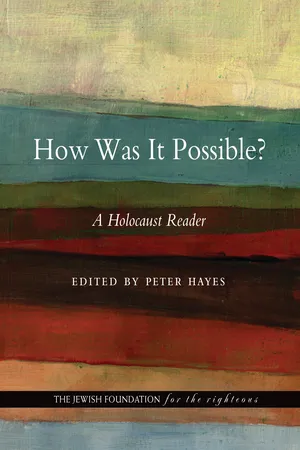
- 904 pages
- English
- ePUB (mobile friendly)
- Available on iOS & Android
eBook - ePub
About this book
As the Holocaust passes out of living memory, future generations will no longer come face-to-face with Holocaust survivors. But the lessons of that terrible period in history are too important to let slip past. How Was It Possible?, edited and introduced by Peter Hayes, provides teachers and students with a comprehensive resource about the Nazi persecution of Jews. Deliberately resisting the reflexive urge to dismiss the topic as too horrible to be understood intellectually or emotionally, the anthology sets out to provide answers to questions that may otherwise defy comprehension.
This anthology is organized around key issues of the Holocaust, from the historical context for antisemitism to the impediments to escaping Nazi Germany, and from the logistics of the death camps and the carrying out of genocide to the subsequent struggles of the displaced survivors in the aftermath.
Prepared in cooperation with the Jewish Foundation for the Righteous, this anthology includes contributions from such luminaries as Jean Ancel, Saul Friedlander, Tony Judt, Alan Kraut, Primo Levi, Robert Proctor, Richard Rhodes, Timothy Snyder, and Susan Zuccotti. Taken together, the selections make the ineffable fathomable and demystify the barbarism underlying the tragedy, inviting readers to learn precisely how the Holocaust was, in fact, possible.
Frequently asked questions
Yes, you can cancel anytime from the Subscription tab in your account settings on the Perlego website. Your subscription will stay active until the end of your current billing period. Learn how to cancel your subscription.
At the moment all of our mobile-responsive ePub books are available to download via the app. Most of our PDFs are also available to download and we're working on making the final remaining ones downloadable now. Learn more here.
Perlego offers two plans: Essential and Complete
- Essential is ideal for learners and professionals who enjoy exploring a wide range of subjects. Access the Essential Library with 800,000+ trusted titles and best-sellers across business, personal growth, and the humanities. Includes unlimited reading time and Standard Read Aloud voice.
- Complete: Perfect for advanced learners and researchers needing full, unrestricted access. Unlock 1.4M+ books across hundreds of subjects, including academic and specialized titles. The Complete Plan also includes advanced features like Premium Read Aloud and Research Assistant.
We are an online textbook subscription service, where you can get access to an entire online library for less than the price of a single book per month. With over 1 million books across 1000+ topics, we’ve got you covered! Learn more here.
Look out for the read-aloud symbol on your next book to see if you can listen to it. The read-aloud tool reads text aloud for you, highlighting the text as it is being read. You can pause it, speed it up and slow it down. Learn more here.
Yes! You can use the Perlego app on both iOS or Android devices to read anytime, anywhere — even offline. Perfect for commutes or when you’re on the go.
Please note we cannot support devices running on iOS 13 and Android 7 or earlier. Learn more about using the app.
Please note we cannot support devices running on iOS 13 and Android 7 or earlier. Learn more about using the app.
Yes, you can access How Was It Possible? by Peter Hayes in PDF and/or ePUB format, as well as other popular books in History & Holocaust History. We have over one million books available in our catalogue for you to explore.
Information
Table of contents
- Cover
- Title Page
- Copyright Page
- Contents
- List of Illustrations
- Foreword
- Introduction
- Editorial Note
- Chapter 1. The Context
- Introduction
- Antisemitism
- Racism
- Contradictions in Central Europe
- Germany’s Turmoil, 1918–1933
- The Interwar Jewish Heartland
- Chapter 2. Nazism in Power
- Introduction
- Elite Cooperation
- Street-Level Coercion
- The Claims of Community
- Aryanization
- Talk of “Annihilation”
- Chapter 3. Impediments to Escape
- Introduction
- The United States and Refugees, 1933–1940
- France: From Hospitality to Hostility
- The Unreceptive British Empire
- Switzerland
- Palestine
- Going and Staying
- Chapter 4. The New Order in Europe
- Introduction
- Culling the German Volk
- Rearranging Populations
- Racial War in the East
- Plunder, Individual and Governmental
- Forced Labor
- Chapter 5. Jews in the Nazi Grip
- Introduction
- Indirect Rule
- Isolation and Impoverishment
- Choiceless Choices
- Leaving a Record
- Nothing to Lose
- Women Slave Laborers
- Robbery in the Netherlands
- Chapter 6. The German Killers and Their Methods
- Introduction
- Deciding to Kill
- Bringing Death to Jews
- Bringing Jews to Death
- Political Soldiers
- The Fates of Gypsies
- Camp Labor
- The Final Frenzy
- Chapter 7. Collaboration and Its Limits
- Introduction
- Poland: The Blue Police
- Romania: Annihilation Aborted
- Vichy France: “Our” Jews and the Rest
- The Italian Paradox
- The Hungarian Paroxysm
- Papal Priorities
- Self-Serving Switzerland
- Chapter 8. Rescuing Jews—Means and Obstacles
- Introduction
- The Kovno Connection
- The Good German of Vilna
- Collective Action in Vivarais-Lignon
- The Hidden Jews of Warsaw
- Saving Jewish Children in Belgium
- American Inhibitions
- Sweden Expands Asylum
- Chapter 9. Aftermath
- Introduction
- Survivors
- Zion’s Ambivalence
- America’s Incomprehension
- The Great Reversal
- The Pathology of Denial
- Restitution and Its Discontents
- After Such Knowledge
- List of Abbreviations
- Source Acknowledgments
- Index
- About Peter Hayes
- About Harvey Schulweis